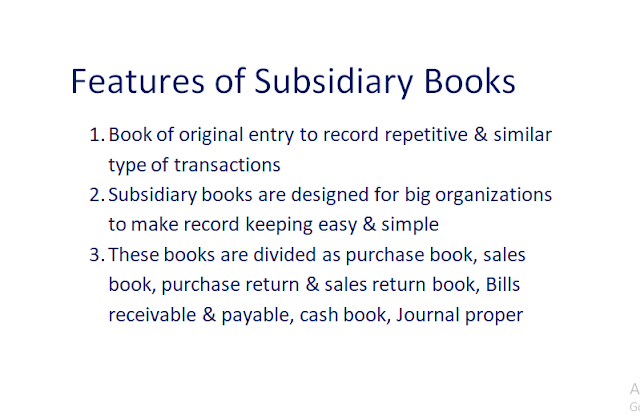Let us know, as to, What are the characteristic features of subsidiary books? Accordingly, let us see its meaning, scope and characteristic features to understand its uses in any organization
What are Subsidiary Books? Meaning, definition, Scope of Subsidiary Books
Subsidiary books are those books that record transactions of similar nature. These are the books of original entry which record the transactions of similar nature or repetitive transactions at one place in chronological order. They are used in place of Journal to record transactions of similar nature or repeated transactions.
In big organisations, recording all the transactions of similar nature in a journal and posting such transactions to ledger accounts involve a lot of clerical work. It would be bulky and voluminous to maintain journal and ledger accounts for such a large variety of transactions of similar nature. To overcome these problems, big organisations will divide the journal into eight different books called Subsidiary books. Each subsidiary book will record transactions of similar nature and repetitive nature. For example, a purchase book will record the transactions relating to purchase of goods on credit from suppliers. The sales book will record the transactions relating to sale of goods on credit to customers. The cash book will record only cash related items such as cash receipts and cash payments.
What are the characteristic features of Subsidiary Books?
1. It is a book of original entry that records all the business transactions which are similar and repetitive in nature.
2. It a substitute for Journal where eight different subsidiary books are used for recording transactions.
3. It is easier to record the transactions into the books of accounts due to the division of work.
4. They are specially designed for big organisations and business firms to make the recording of transactions simple, easy, fast manner.
5. These books help to divide the work and to record the transactions of similar nature and repetitive nature at one place.
6. These books are divided into eight different books. They are classified as purchase book, sales book, cash book, sales return book, purchase return book, bills receivable, bills payable book, journal proper.
7. Cashbook is further divided as a single column, double column and triple column book. Triple column cash book has discount column, bank & cash column specially designed for large organisations. Cashbook is used to record only cash related transactions
8. Purchase book and sales book are used to record the transactions relating to credit purchase and credit sale of goods and services
9. Sales return book is used to record the transactions relating to return of goods by customers which were sold on credit to customers. Similarly, the Purchase return book is used to record the goods returned to suppliers which were purchased earlier on credit
10. Bills receivable and bills payable books to record transactions relating to bills issued or received from customers or suppliers
11. Journal Proper is used to record the transactions which were not recorded in any of the above subsidiary books. For example, the purchase of machinery on credit will be recorded in the journal proper
Conclusion
Thus, we can conclude, as to, what are the characteristic features of subsidiary books? We can conclude that it is a book of original entry that records all the business transactions which are similar and repetitive in nature. These books are used by big organizations where the volume of transactions are very high
Related blogs:
What is Journal? Its features, types, Objectives and uses
What are Ledgers?
What is Trial Balance?
What are Financial Statements? Its features, types, uses
What is Income Statement (Profit and loss a/c)?
What is Balance Sheet (Position Statement)?
What is Cash Flow Statement?
What is Bookkeeping? Its features, objectives, uses?
What is Single Entry System? Its features, types, objectives, uses
What is Double Entry System? Its features, objectives, uses


Post a Comment
if you have queries let me know and mail me at syednissaruddin99@gmail.com